![]()
![]()
![]()
Use LEFT and RIGHT arrow keys to navigate between flashcards;
Use UP and DOWN arrow keys to flip the card;
H to show hint;
A reads text to speech;
104 Cards in this Set
- Front
- Back
|
Macromolecules |
Large complex molecules with emergent properties that arise from the orderly arrangement of their atoms 4 classes: Carbohydrates Lipids Proteins Nucleic acids |
|
|
Polymer |
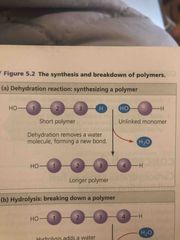
A long molecule consisting of many similar building blocks linked by covalent bonds Carbs proteins and nucleic acids |
|
|
Monomers |
Repeating units that serve as building blocks for polymers Smaller molecules Some have functions on their own |
|
|
Dehydration reaction |
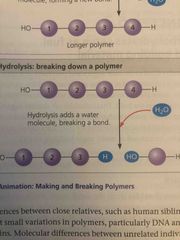
Occurs when 2 monomers form a covalent bond through the loss of a water molecule Dehydration synthesis requires energy. An energy-investing process |
|
|
Hydrolysis |
Polymers dissembled to monomers Reverse of dehydration reaction Adding water molecules Energy releasing process Ie: Process of digestion |
|
|
Enzymes |
Specialized macromolecules Speed up chemical reactions such as those that make or break down polymers |
|
|
Diversity of polymers |
Cell has thousands of different macromolecules Macromolecules vary among cells of an organism, vary within a species, and vary even more btw species Huge variety of polymers can be built from a small set of monomers |
|
|
Carbohydrates |
Sugars and the polymers of sugars Simplest carbs are monosaccharides (simple sugars) Carb macromolecule are polysaccharides (polymers composed of many sugar bldg blocks) |
|
|
Monosaccharides |
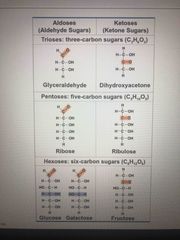
Glucose Have molecular formulas that are usually multiples of CH2O Location of carbonyl group makes it either (aldose or ketose) Can tell by number of carbon (3-7 carbons long) |
|
|
Monosaccharides |
Glucose Have molecular formulas that are usually multiples of CH2O Location of carbonyl group (aldose or ketose) Can tell by number of carbon |
|
|
Disaccharides |
Formed when 2 monosaccharides join when a dehydration reaction happens (Glycosidic linkage) |
|
|
Glucosidic linkage |
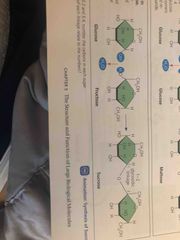
Covalent bond formed btw 2 monosaccharides by a dehydration reaction |
|
|
Polysaccharides |
Polymers of sugars with a few hundred to a few thousand monosaccharides joined by glycosidic linkages Jobs includes storage and structural (holding things together ) |
|
|
Starch |
A storage polysaccharide of plants (synthesizing starch allows plants to store glucose) Using hydrolysis, the plant can access this stored energy (breaks down the glucose monomers) Consists of glucose monomers Simplest form: amylose |
|
|
Amylopectin |
Somewhat branched Makes a 1-4 (number 1 carbon to number 4 carbon) linkage and a 1-6 linkage |
|
|
Granules |
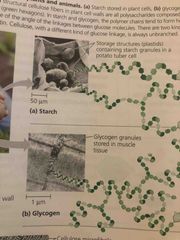
Plants store starch as these within chloroplasts and other plastids |
|
|
Glycogen |
Storage of polysaccharide in animals Like amylopectin but more branched (allows for more free ends to be available for hydrolysis) Stored in liver and muscles. We store about one day supply Put in places that have high energy needs so it is easily accessible to break down and get more ATP. Done by hydrolysis |
|
|
Cellulose |
Structural polysaccharide Major component of plant cell walls 1-4 linkages Differ from starch in that they are in the b configuration or upside down (alcohol grp for starch is in a or at the top) |
|
|
Storage polysaccharides |
Starch Glycogen |
|
|
Structural polysaccharides |
Cellulose Chitin |
|
|
Differences in starch vs cellulose |
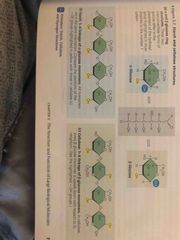
Differ from starch in that they are in the b configuration or upside down (hydroxyl grp for starch is in a or at the top) Differ glycosidic linkages gives distinct 3 dimensional shapes (starch is helical, cellulose is straight) |
|
|
Microfibils |

Parallel cellulose molecules held together, not branched, free to bond with other hydroxyls Strong Allow for hydrogen bonds |
|
|
Digestion of cellulose |
Enzymes that digest a linkages are unable to digest b linkages (due to different shapes of the molecules) Most animals including humans cannot digest cellulose but some have microbes in gut that do it for them Cellulose passes through the digestive tract and stimulates the lining to secrete mucus which aids in smooth passage (insolvable fiber) |
|
|
Helical (starch) |
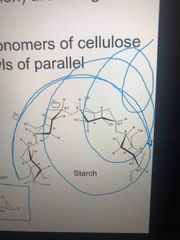
Back (Definition) |
|
|
Chitin |
Found in exoskeleton of arthropods Provide support for cell walls of fungi |
|
|
Catalysts |
Speed up chemical reactions Proteins/enzymes |
|
|
Polypeptides |
Unbranched polymers built from same set of 20 amino acids |
|
|
Amino acids |
Organic molecules with amino and carboxyl groups Differ in their properties due to differing side chains (r groups) |
|
|
R group |
Side chains that create difference in properties of amino acids |
|
|
20 amino acids of proteins |
Grouped according to R group 9 are hydrophobic and nonpolar 6 are hydrophilic and polar 2 are acidic, hydrophilic, negative charge 3 are basic positive charge |
|
|
9 of 20 amino acids (yellow) |
Nonpolar, hydrophobic Hydrocarbons |
|
|
Hormonal proteins |

Coordination of an organisms activities Insulin, a hormone, causes other tissues to take up glucose |
|
|
Receptor proteins |
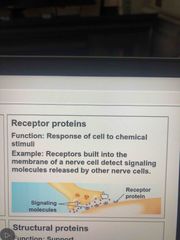
Response of cell to chemical stimuli Receptors built into the membrane of a nerve cell detect molecules |
|
|
Contractile/motor proteins |
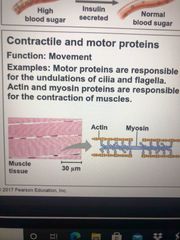
Movement Actin and myosin proteins are responsible for muscles contracting |
|
|
A polymer of amino acids that range in length |
A polypeptide The chain can range from a few to 1,000 monomers Starts with C-terminus and ends with n-terminus |
|
|
Polypeptide chain |
Starts with C-terminus ( carboxyl) and ends with n terminus (amino) Backbones Linked by peptide bond |
|
|
Amino acids |
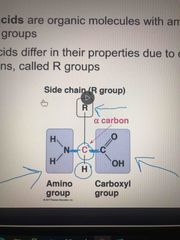
Organic molecules with amino and carboxyl groups Differ in their properties due to differing side chains (r groups) |
|
|
Protein structure |
Proteins activities are a result of their 3 dimensional architecture They consist of one or more polypeptides precisely folded, twisted, and coiled into a unique shape |
|
|
20 amino acids of proteins |
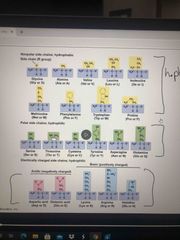
Grouped according to R group 9 are hydrophobic and nonpolar 6 are hydrophilic and polar 2 are acidic, hydrophilic, negative charge 3 are basic positive charge |
|
|
9 of 20 amino acids (yellow) |
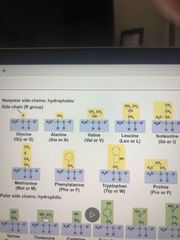
Nonpolar, hydrophobic Hydrocarbons |
|
|
6/20 amino acids (green) |
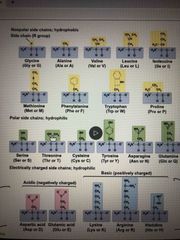
Polar, hydrophilic Lots of oxygen, wants to tact with water |
|
|
2/20 and 3/20 amino acids (pink and blue) |
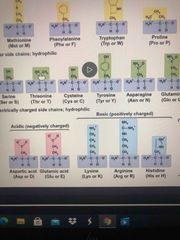
2 Acidic, negative charge, carboxyl 3 basic positive charge, amino groups=base |
|
|
2 types of secondary structure |
Hydrogen bonds determine which way the coils will fold Alpha helix Beta pleated sheet Partial positive and partial negative allow for hydrogen binding and location fo atom |
|
|
Tertiary structure |
Shape of polypeptide, results from interactions btw R groups ( not backbone) Include hydrogen And ionic bonds, hydrophobic interactions, and van der waals Disulfide bridges Some proteins stop here |
|
|
Disulfide bridges |
Strong covalent bonds that reinforce protein structure in tertiary level |
|
|
Quaternary structure |
When 2 or more polypeptide chains form one macromolecule Collagen and hemoglobin Hood and the sleeves added to the sweater vest |
|
|
Collagen and hemoglobin |
Quaternary structures Collagen has 3 polypeptides coiled like a rope Hemo has 4 polys: 2 alpha and 2 beta |
|
|
Enzymatic function |
Acceleration of chemical reactions (Hydrolysis and digestion) |
|
|
Primary structure |
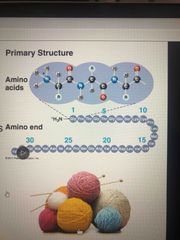
Sequence of amino acids determined by inherited genetic info The yarn of the sweater made of a bunch of fibers that come together in a long linear molecule |
|
|
Storage proteins |
Storage of amino acids (Breast milk has casein, plants have storage proteins in seeds, egg white has ovalbumin) |
|
|
2 types of secondary structure |
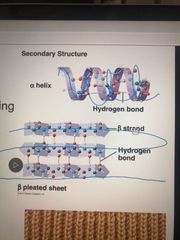
Hydrogen bonds determine which way the coils will fold Alpha helix Beta pleated sheet Partial positive and partial negative allow for hydrogen binding and location fo atom |
|
|
Tertiary structure |
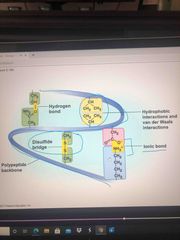
Shape of polypeptide, results from interactions btw R groups ( not backbone) Include hydrogen And ionic bonds, hydrophobic interactions, and van der waals Disulfide bridges Some proteins stop here |
|
|
Receptor proteins |
Response of cell to chemical stimuli Receptors built into the membrane of a nerve cell detect molecules |
|
|
Quaternary structure |

When 2 or more polypeptide chains form one macromolecule Collagen and hemoglobin Hood and the sleeves added to the sweater vest |
|
|
Collagen and hemoglobin |
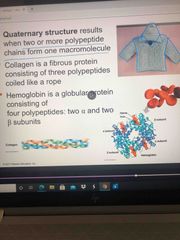
Quaternary structures Collagen has 3 polypeptides coiled like a rope Hemo has 4 polys: 2 alpha and 2 beta |
|
|
Sickle cell disease |
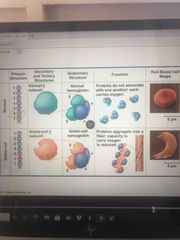
A change in primary structure One amino acid is replaced by valine which changes the structure of the protein making it difficult to travel through blood stream |
|
|
Denaturation |
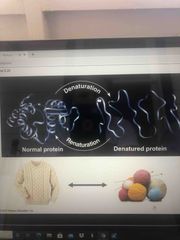
Loss of protein structure, unfolding Becomes biologically inactive Due to alterations in the environment (pH, salt concentration, temp, etc) |
|
|
Renaturation |
Can’t always do it and usually the protein is left in functional. Can take a lot of effort and is not always possible |
|
|
Folding of protein |
Hard to predict a proteins structure from it’s primary structure Several stages before stable and may have “help” along the way (isolate folding protein from environment) Misfolding leads to Alzheimer’s, mad cow disease, and other neurodegenerative disorders |
|
|
Methods to determine protein structure |
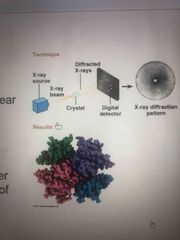
X-ray crystallography Nuclear magnetic resonance (nmr). Does not require protein crystallization Bioinformatics-from amino acid sequences |
|
|
Gene |
Made of DNA Amino acid sequence of a polypeptide programmed by a unit of inheritance |
|
|
Nucleotide polymers |
Linked together to build a polynucleotide Adjacent nucleotides are joined by a phosphodiester linkage Create backbone of sugar-phosphate units and nitrogenous bases Sequence of bases is unique for each gene |
|
|
Phosphodiester linkage |
Phosphate groups that link the sugars of 2 nucleotides |
|
|
Appendages |
Nitorgenouses bases that are bonded to the backbone of sugar-phosphate units Along the appendages as you go down are unique for each gene |
|
|
Families of nitrogenous bases |
Pyrimidines Purines |
|
|
Pyrimidines |
C, U, T ( cut the py) Have a single 6-membered ring Cytosine, Thymine (only found in DNA), Uracil (only found in RNA) |
|
|
Purines |
A, G Have a 6 membered ring fused to a five membered ring Adenine, guanine |
|
|
Complementary base pairing |
Only certain bases in DNA pair to form hydrogen bonds: Adenine A=thymine T Guanine G=cytosine C The pairing is always a pyrimine and a purimine |
|
|
Nucleic acid |
DNA Made of monomers called nucleotides |
|
|
Two types of nucleic acid |
DNA RNA |
|
|
Deoxyribonucleic acid |
Provides directions for its own replication Directs synthesis of messenger mRNA controlling protein synthesis |
|
|
Gene expression |
Turning DNA instruction manual through RNA into a protein |
|
|
Polynucleotides |
Nucleic acids are polymers of nucleotides |
|
|
Nucleoside |
Nitrogenous base + sugar |
|
|
Nucleotide |
Monomer Nucleoside + phosphate group Consist of nitrogenous base, pentode sugar, 1 or more phosphate groups |
|
|
DNA sugar |
Deoxyribose |
|
|
Sugar RNA |
Ribose |
|
|
Gene |
Made of DNA Amino acid sequence of a polypeptide programmed by a unit of inheritance |
|
|
Nucleotide polymers |
Linked together to build a polynucleotide Adjacent nucleotides are joined by a phosphodiester linkage Create backbone of sugar-phosphate units and nitrogenous bases Sequence of bases is unique for each gene |
|
|
Phosphodiester linkage |
Phosphate groups that link the sugars of 2 nucleotides |
|
|
Appendages |
Nitorgenouses bases that are bonded to the backbone of sugar-phosphate units Along the appendages as you go down are unique for each gene |
|
|
Families of nitrogenous bases |
Pyrimidines Purines |
|
|
Pyrimidines |
C, U, T ( cut the py) Have a single 6-membered ring Cytosine, Thymine (only found in DNA), Uracil (only found in RNA) |
|
|
Purines |
A, G Have a 6 membered ring fused to a five membered ring Adenine, guanine |
|
|
Nucleotide |
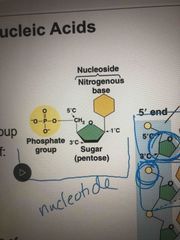
Monomer Nucleoside + phosphate group Consist of nitrogenous base, pentode sugar, 1 or more phosphate groups |
|
|
DNA sugar |
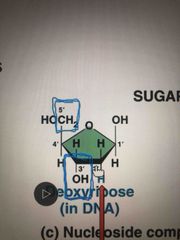
Deoxyribose |
|
|
Sugar RNA |
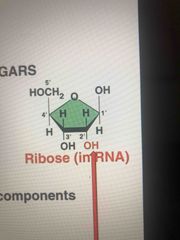
Ribose |
|
|
Nucleotide polymers |
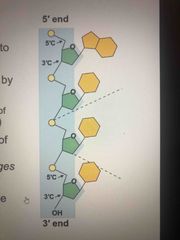
Linked together to build a polynucleotide Adjacent nucleotides are joined by a phosphodiester linkage Create backbone of sugar-phosphate units and nitrogenous bases Sequence of bases is unique for each gene |
|
|
Gene expression |
Turning DNA instruction manual through RNA into a protein |
|
|
Polynucleotides |
Nucleic acids are polymers of nucleotides |
|
|
Nucleoside |
Nitrogenous base + sugar |
|
|
Nucleotide |
Monomer Nucleoside + phosphate group Consist of nitrogenous base, pentode sugar, 1 or more phosphate groups |
|
|
Purines |
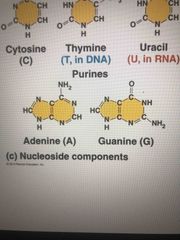
A, G Have a 6 membered ring fused to a five membered ring Adenine, guanine |
|
|
Complementary base pairing |
Only certain bases in DNA pair to form hydrogen bonds: Adenine A=thymine T (uracil replaces T if RNA) Guanine G=cytosine C The pairing is always a pyrimidines and a purines |
|
|
What makes DNA able to replicate itself? |
Complementary base pairing Also used to make RNA molecule to take message to protein |
|
|
Double helix |
DNA molecules have 2 polynucleotides spiraling around an imaginary access Held together by hydrogen bonds Genetic material is not in the center |
|
|
Antiparallel |
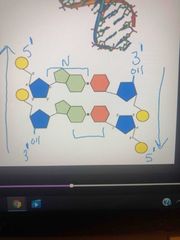
Backbones of DNA in opposite 5 to 3 directions from each other |
|
|
One DNA molecules contains... |
Many genes! On long polymer contains many genes |
|
|
RNA |
Single strand Complementary pairing can occur by folding over itself creating different shapes (allows for transfer RNA) |
|
|
Gene expression |
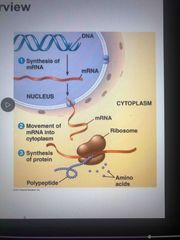
Flow of genetic info: DNA to RNA to protein |
|
|
Genomics and proteomics |
DNA sequencing (decoding) started in the 1970s Human genome project |
|
|
Bioinformatics |
Computer software and other tools to deal with the data resulting from sequencing many genomes |
|
|
Genomics |
Analyzing large sets of genes or even comparing whole genomes of different species |
|
|
Proteomics |
A similar analysis of large sets of proteins including their sequences |

